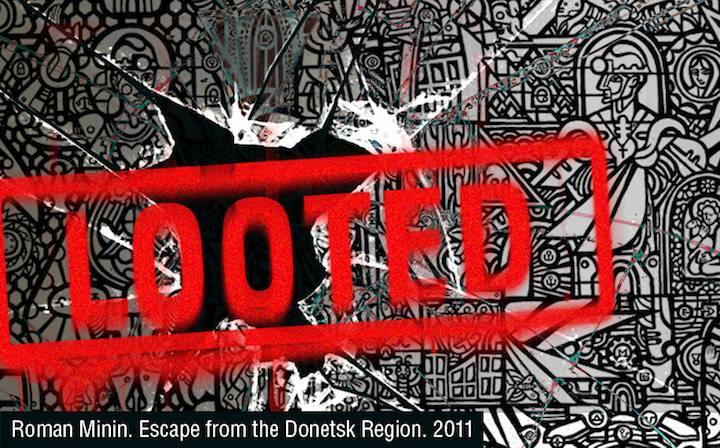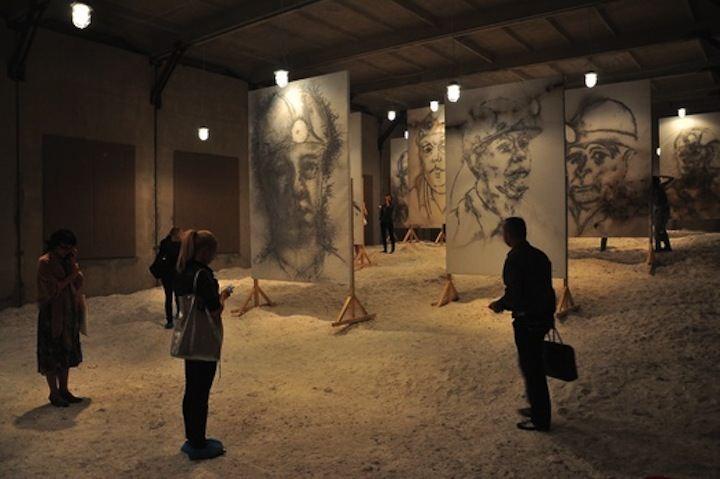Ukrainian Art Center Seized by Armed Separatists
While New Yorkers were standing in line for tickets to the thrilling new “Macbeth” that has, according to the New York Times, transformed the Park Avenue
Armory into a war zone, pro-Russian separatists wearing masks and armed with Kalashnikovs invaded Izolyatsia Foundation, an innovative arts center in Donetsk, Ukraine, and set up a makeshift
armory.
In a tale of betrayal and ambition that Shakespeare might have crafted, curator Olena Chervonik reported on the siege: “On the evening of June 8, we
received a phone call from the so-called minister of social politics in the separatist government, who warned us that there would be a takeover the next day. As it turned out, he was actually the
person who organized and supervised the takeover.
"Now he claims that he was not involved in the decision to attack Izolyatsia and that, on the contrary, he was trying to warn
us. We’ve known this man for quite some time,” she continued. “He's been visiting Izolyatsia’s events, often bringing his family. He once told us that he was doing
various political PR campaigns for whatever party will pay him. The Donetsk People’s Republic [DPR] is yet another political machine that he is working for.”

“Initially this minister of the self-proclaimed DPR allowed Izolyatsia’s art
collection to be evacuated,” she continued. “We managed to save about one-third of our collection. The rest remained on site, if it is still there. We also have a lot of art works
that were created in-situ, so we could not remove them.
"The night of the takeover, his people knocked down all the doors of Izolyatsia’s offices and started
stealing whatever they deemed valuable. Aware of the plundering, the foundation issued an open appeal to the DPR. The next day, Izolyatsia’s staff were informed that they would not be able
to take anything else and more armed people moved onto the site. We don’t know exactly what they are storing there, but we know for a fact that they have started cutting up various metal
structures to sell as scrap metal. Izolyatsia’s premises are being ruined."

Cai Guo-Qiang: 1040m Underground features two site-specific installations, including a series of gunpowder drawings produced on the IZOLYATSIA
campus in 2011.
Izolyatsia has hosted internationally acclaimed artists such as Cai Cuo-Qiang, who created two
site-specific installations at the cultural center in 2011. Daniel Buren did several installations 2012. A commitment to the
local community is at the forefront of Izolyatsia’s activities, “inviting participation and immersion into a resource sadly lacking in southeastern Ukraine,” according
to the foundation’s mission statement.
Founded as a non-governmental arts foundation in 2010
by Luba Michailova, a Donetsk native, Izolyatsia rented space in a former insulation materials factory where Michailova’s father had been a director until the
factory went bankrupt in the 1990s. The foundation also inherited the factory’s name. Michailova established Izolyatsia “to preserve the industrial heritage of the region and
simultaneously to construct something new, which would inspire social and cultural development.”
Clearly, Izolyatsia is no longer insulated from the separatist violence that
has ravaged the region in recent months. The foundation’s staff and artists have relocated to Kiev, “hoping that it's going to be a
temporary move,” says Chervonik. “We are planning to create a virtual platform for people who left Donetsk: first a website with their testimonies and life stories and later some sort
of think-tank that can generate ideas about economic and cultural renaissance of the Donbas region. The immediate plans include our summer exhibition, which we now plan to hold in Kiev later in the
season.”
I first met Olena Chervonik at a Ukrainian restaurant in Manhattan’s East Village through a mutual friend who had told her about my work. When
Chervonik invited me to exhibit photographs from my book, Transitory Gardens, Uprooted Lives along
with prints by Ukrainian artist Pavlo Makov at Izolyatsia this summer, I looked forward to returning to the region where I had photographed industrial ruins in 2005, so that I could experience firsthand Izolyatsia’s aim “to provide a hub of cultural excellence delivering social,
economic and ecological transformation to a post-industrial hinterland.” As of this week, I am hoping to travel to Kiev in late July.


